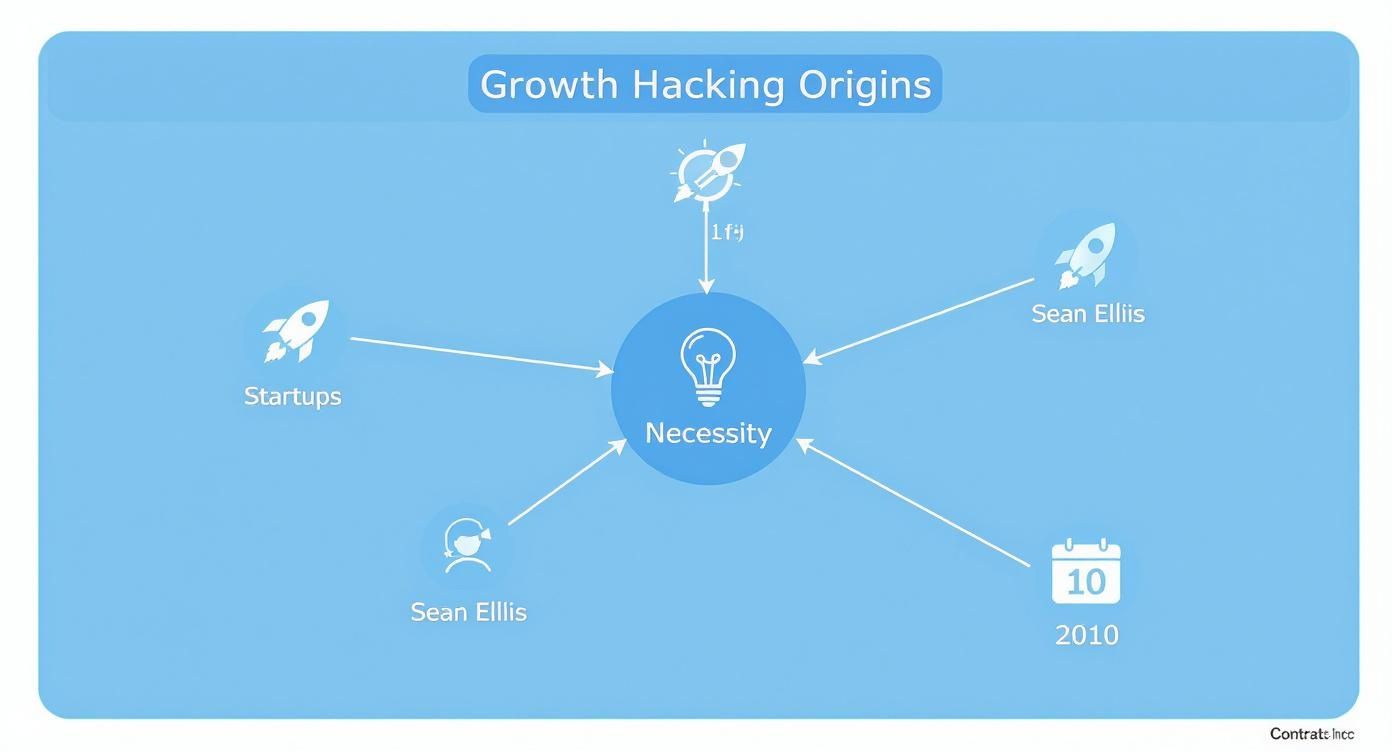What Is Growth Hacking: A Beginner's Guide
So, what’s all this “growth hacking” buzz about, really?
At its core, growth hacking is a process of rapid-fire experimentation across every part of your business—from marketing and sales to product development—all to find the fastest, most efficient ways to grow. Forget traditional, slow-burn marketing. This is about using a data-obsessed approach to uncover scalable, often low-cost strategies for grabbing and keeping users.
What Is Growth Hacking in Simple Terms?

Let's cut through the jargon with a quick analogy. Think of a traditional marketer as a careful farmer, tending their crops over a full season using time-tested methods. They know what works, and they stick to it.
A growth hacker? They’re more like a botanist in a high-tech lab, running hundreds of tiny experiments at once. They’re tweaking the soil, adjusting the light, and changing the nutrients on the fly to discover the absolute quickest formula for a monster harvest.
This isn't about some secret bag of tricks. It's a mindset that’s completely fixated on one thing: scalable growth. It’s where creative marketing, hard data, and product design all smash together to find new ways to pull customers in and make them want to stay.
It's a Mindset, Not Just a Method
When you get right down to it, growth hacking is just a different way of thinking. It changes the conversation around business growth by asking entirely different questions.
A traditional marketer might ask, "How much budget do we need for a big campaign?" A growth hacker, on the other hand, asks, "What's the smallest, cheapest experiment we can run today to learn something new about our customers?"
This entire approach is built on a few core beliefs:
- Data Over Gut Feelings: Every move is backed by data, not just a hunch. Growth hackers are glued to their metrics, tracking user behavior to prove (or disprove) their ideas.
- Growth Is a Team Sport: This isn't just a job for the marketing department. It demands that marketers, engineers, product managers, and data analysts all work together to bake growth right into the product itself.
- Test, Learn, Repeat. Fast. The goal is to throw ideas at the wall quickly, see what sticks, and iterate. This high-tempo testing lets teams find winning strategies and ditch the losers before wasting a ton of time and money.
And since the product is often the main engine for growth, it’s worth taking a minute to understand what product growth truly entails and how it connects to this whole process.
"It’s about figuring out why you grow and then trying to make that happen on purpose again and again."
Ultimately, growth hacking is about building a sustainable, repeatable engine for growth—not just chasing temporary spikes in traffic. It's a systematic game plan built for today's hyper-competitive world.
To really nail the difference, here's a quick look at how the two mindsets stack up.
Traditional Marketing vs Growth Hacking Mindset
| Primary Goal | Brand awareness, lead generation | Scalable user acquisition and retention |
|---|---|---|
| Process | Planned, long-term campaigns | Rapid, iterative experiments (sprints) |
| Focus | Top of the funnel (awareness) | The entire customer lifecycle |
| Metrics | Impressions, reach, brand sentiment | Conversion rates, LTV, virality, churn |
| Team Structure | Siloed (marketing department) | Cross-functional (product, data, marketing) |
| Budgeting | Large, pre-approved budgets | Small, flexible, data-driven allocation |
As you can see, it's less about a specific channel and more about a fundamental shift in how you approach the entire problem of growing a business.
The Silicon Valley Origins Of Growth Hacking
In early Silicon Valley, startups weren’t judged by brand logos or glossy ads—they lived or died on one metric: how quickly they could add users.
With shoestring budgets and sky-high expectations, traditional marketing felt like a luxury. No six-figure ad buys. No months-long brand campaigns. What these teams needed was a hybrid role—part marketer, part engineer—singularly focused on finding clever shortcuts to growth.
Enter Sean Ellis. In July 2010, he coined growth hacking to describe someone whose entire mission is accelerating user acquisition through constant experimentation and data analysis.
Born From Necessity
These pioneers couldn’t simply throw money at a problem. Instead, they:
- Mapped every step of the signup funnel
- Ran rapid-fire A/B tests on headlines, CTAs, and layouts
- Dug into usage data to squeeze maximum results from minimal spend
“Growth hacking isn’t just a collection of tactics; it’s a strategic answer to a specific business challenge that demanded innovation, speed, and an obsessive focus on data.”
That relentless, test-and-learn approach fueled early wins. Dropbox rewarded referrals with extra storage instead of splurging on billboards. Airbnb tapped niche forums and neighborhood blogs before ever dreaming of a TV spot. The payoff? Massive scale without massive budgets.
These tiny, surgical experiments—rather than broad awareness pushes—became the blueprint for rapid expansion. Each tweak revealed what truly motivated a visitor to become a user.
Understanding this origin story makes one thing clear: growth hacking isn’t a passing fad. It’s a survival playbook born under pressure, a framework any brand can adapt when the goal is fast, smart, and budget-savvy expansion.
Understanding the Core Principles
So, what’s really going on under the hood of growth hacking? It’s not just a grab bag of tricks; it’s a disciplined system built on a few powerful ideas. Forget thinking about marketing as something you bolt on after the product is built.
Instead, growth hacking boils down to three core pillars: a product-led mindset, relentless data-driven experimentation, and a deep focus on the entire customer journey.
A Product That Sells Itself
First up, growth hackers see the product itself as the main engine for growth. They’re constantly asking questions like, "How can we build features that get users to share this?" or "Can we create an upgrade path that's so compelling, people can't resist?"
This approach bakes marketing directly into the user experience, creating a loop where the product's value naturally brings in new customers.
Test Everything, Trust the Data
This product-led approach is fueled by a lab-coat mentality. Growth hackers live in a constant cycle: hypothesize, test, measure, and iterate. Every idea, from a new headline on the homepage to a different referral bonus, is treated as a testable experiment.
Data, not someone's gut feeling, decides what stays and what gets tossed.
"A growth hacker is a person whose true north is growth. Everything they do is scrutinized by its potential impact on scalable growth."
- Sean Ellis, the guy who coined the term "Growth Hacking"
This infographic nails how the whole idea was born out of necessity. Sean Ellis came up with it back in 2010 because startups needed a practical way to scale fast with shoestring budgets.

As you can see, it wasn't some stuffy academic theory. It was a real-world solution to the high-pressure challenge of getting big without a big wallet.
Optimizing the Entire Customer Journey
Finally, growth hacking looks way beyond just getting new users through the door. It meticulously optimizes every single stage of the customer lifecycle. A popular framework for this is the "Pirate Funnel" (AARRR), which breaks the journey into five distinct, measurable stages:
- Acquisition: How do people find you in the first place?
- Activation: Do they have a great first experience that makes them go "aha!"?
- Retention: Do they stick around and come back for more?
- Referral: Are they so happy they tell their friends?
- Revenue: How do you actually turn users into dollars?
By focusing on improving the numbers at each stage, growth hackers build a sustainable growth machine—not just a leaky bucket that constantly needs refilling. A great place to spot opportunities in this funnel is by seeing what your rivals are up to. You can learn more about how to conduct competitor analysis to find gaps and get ahead.
Real-World Growth Hacking Examples

Theory is one thing, but seeing growth hacking in the wild is what makes it all click. The most legendary examples aren't just clever marketing tricks; they're masterclasses in understanding what makes people tick and using that knowledge to trigger explosive, low-cost growth.
Instead of just dumping money into ads, these companies baked growth right into their product. They turned the user experience itself into a marketing engine.
Dropbox and the Referral Machine
When Dropbox launched, the cloud storage market was already getting crowded, and paying for ads was brutally expensive. Their solution was so simple it was genius: a two-sided referral program.
Invite a friend, and when they sign up, you both get extra storage space for free. This wasn't some flimsy promo; it was a core product feature that turned every user into a motivated salesperson.
The results were insane. The Dropbox referral program famously led to a permanent 60% increase in signups. It proved that if you give people a good reason to spread the word, they absolutely will.
Airbnb’s Craigslist Coup
In the early days, Airbnb had a classic startup problem: a brilliant product but no audience and zero marketing budget. Their team figured out that the exact people they needed—folks looking for alternative lodging—were already hanging out on one platform: Craigslist.
So, they built a clever (and technically unofficial) integration. With a single click, hosts could cross-post their Airbnb listings directly to Craigslist, instantly putting their properties in front of millions of potential renters. They tapped into a massive, pre-built audience without spending a dime.
These stories aren't just history; they're a playbook. Here are the core lessons:
- Build a Viral Loop: Don't just ask for shares; build sharing mechanics directly into your product.
- Leverage Existing Networks: Find where your target audience congregates online and meet them there. Don't try to build a party from scratch.
- Offer Real, Tangible Value: The incentive to share has to be genuinely useful for both the person sharing and the person they invite.
For new companies, getting those first users is the ultimate growth hacking test. You can find some killer modern tactics in this guide on How to Acquire Early Users Without Ad Spend. These foundational examples show that the best growth hacks aren't just about being clever; they’re about deeply aligning your product with what your users actually want and need.
The Measurable Impact on Business Growth
Cool tactics are fun, but they’re useless if they don’t move the needle. This is where growth hacking really earns its keep—it’s not about abstract theories, it’s about delivering real, measurable results that show up on the bottom line.
When done right, this data-obsessed approach directly impacts the KPIs that actually matter. The whole point is to make growth more efficient and sustainable. For example, by rapidly testing acquisition channels, a company can slash its Customer Acquisition Cost (CAC). At the same time, by focusing on keeping users happy and engaged, they boost the Customer Lifetime Value (LTV).
It’s a simple, powerful formula: spend less to get better customers who stick around longer.
Driving Tangible Financial Returns
This isn't just talk. The numbers from real-world case studies show how growth hacking fuels both revenue and user growth in a big way.
"A systematic growth hacking process delivers scalable financial returns by optimizing every stage of the customer journey, from the first click to the final sale."
In some sectors, this methodology has been shown to pump up click rates by 8–10% and streamline purchase paths by 10–12%. We’ve seen retail clients get even crazier results, with one reporting a massive 450% increase in monthly revenue after putting these principles into action. If you want to dig deeper into these kinds of outcomes, you can learn more by exploring the meaning and implications of growth hacking.
Ultimately, every experiment, every A/B test, every tweak is designed to supercharge conversion rates. By finding and fixing the friction points in the user journey, growth hacking turns more curious visitors into active users, and more of those users into paying customers.
Optimizing these conversions is a science, and having the right setup is critical. Check out our guide on the best conversion rate optimization tools to see how you can start measuring and improving your own metrics.
Your First Steps into Growth Hacking
Alright, let's move from theory to action. Getting started with growth hacking isn't about launching some massive, complicated campaign overnight. It's about taking small, deliberate steps to build momentum and prove that this whole data-driven, experimental thing actually works.
The very first step is mental. You have to adopt a growth mindset. This is a huge shift. Instead of just executing pre-planned campaigns, you'll be running a non-stop cycle of tiny experiments. Stop asking, "What should our next big ad campaign be?" Start asking, "What's the smallest test we can run this week to nudge our user activation rate up by 1%?"
Identify Your North Star Metric
To make any progress, you need a compass. In growth hacking, that compass is your North Star Metric (NSM). Some call it the One Metric That Matters (OMTM), but the idea is the same: it's the single number that best captures the core value your product delivers to customers. It’s the metric that gets your entire team rowing in the same direction.
Here’s what that looks like in the real world:
- For Spotify: It’s probably something like "Time spent listening."
- For Airbnb: It’s almost certainly "Nights booked."
- For an e-commerce store: It might be "Monthly repeat purchases."
Once you nail this down, every single growth experiment you run should be designed to move that number. This laser focus keeps you from chasing vanity metrics—like social media likes—that feel good but don't actually grow the business.
Start Running Small Experiments
With your NSM defined, it's time to brainstorm. A dead-simple way to get ideas flowing is to ask "How might we..." questions for each stage of the customer journey. For example, "How might we make our onboarding process so good that people can't help but finish it?"
Next, turn those ideas into simple, low-risk tests. You don't need a bunch of expensive software to get going. Free tools like Google Analytics for tracking what people do and Google Optimize for A/B testing are perfect starting points.
The goal isn't to find a "silver bullet" on your first try. The goal is to build a repeatable process of hypothesizing, testing, and learning that accumulates small wins over time.
This experimental mindset is absolutely critical for new ventures. You can find more targeted advice in our guide on digital marketing for startups, which dives into applying these lean principles right from day one. By taking these first few steps, you're not just running tests—you're building a powerful engine for sustainable growth.
Got Questions? We’ve Got Answers.
As the buzz around growth hacking gets louder, a few key questions always seem to surface. It’s a term that gets thrown around a lot, so let's clear the air and dig into what it really means for you, whether you’re running a scrappy startup or a Fortune 500 giant.
"Isn't Growth Hacking Just for Startups?"
Nope. That’s probably the biggest myth out there. Sure, growth hacking was born in the pressure-cooker environment of Silicon Valley startups—where you either grow or die—but its DNA has been adopted by the big leagues.
Companies like Amazon, Netflix, and Spotify are basically giant growth hacking machines. They’re running thousands of data-driven experiments every single day to fine-tune the user experience, keep people hooked, and drive sales. The only real difference is the scale. A startup might test a new landing page on a few hundred visitors, while a behemoth like Amazon tests a button color on millions. The mindset of relentless, data-backed experimentation? Exactly the same.
"So, How Is This Different from Plain Old Digital Marketing?"
Good question. They definitely overlap, but their playground and their goals are different. Think of a digital marketer as a specialist, a master of driving awareness and getting people in the door using established channels like SEO, content, and paid ads.
Growth hacking, on the other hand, is a much broader game. It’s a cross-functional obsession with the entire customer journey. It’s not just about getting users—it’s about activating them, keeping them around, and turning them into raving fans who do the marketing for you.
A digital marketer runs campaigns on specific channels. A growth hacker runs experiments across the entire business—product, engineering, sales, you name it—to find the absolute fastest, most efficient path to growth.
The core difference is the process. Digital marketing often sticks to planned, longer-term campaigns. Growth hacking is all about high-speed, iterative testing where everyone—from product folks to engineers and marketers—huddles up to find those secret levers that unlock scalable growth.
"What Kind of Skills Does a Growth Hacker Actually Need?"
A top-tier growth hacker is what we call T-shaped. This just means they have super deep expertise in one or two key areas but also have a broad, working knowledge of a bunch of others.
Their deep skills might be in something like:
- Data Analytics: The uncanny ability to dive into user data and pull out golden nuggets of insight that no one else sees.
- Conversion Rate Optimization (CRO): A true mastery of A/B testing, user psychology, and figuring out what makes people click.
- Paid Acquisition: Knowing the ins and outs of platforms like Google Ads or paid social like the back of their hand.
But here’s the kicker: they also need to know enough about other fields—like basic coding, UX/UI design principles, and killer copywriting—to be dangerous. This versatility is their superpower. It lets them dream up and launch experiments on their own, without having to wait in line for help from five different departments for every little test.
At Rebus, we don’t just talk about this stuff—we live it. This experimental, data-first mindset is baked into everything we do. Whether we’re optimizing your paid search campaigns or building out your entire customer lifecycle, our mission is to build a sustainable growth engine for your business.
